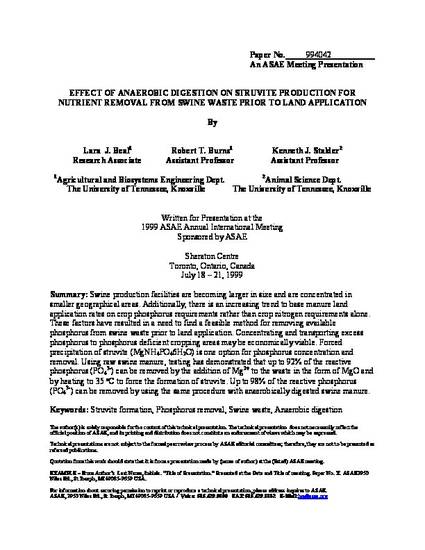
Presentation
Effect of anaerobic digestion on struvite production for nutrient removal from swine waste prior to land application
Presentation at the 1999 ASAE Annual International Meeting, July 18-21, 1999.
(1999)
Abstract
Swine production facilities are becoming larger in size and are concentrated in smaller geographical areas. Additionally, there is an increasing trend to base manure land application rates on crop phosphorus requirements rather than crop nitrogen requirements alone. These factors have resulted in a need to find a feasible method for removing available phosphorus from swine waste prior to land application. Concentrating and transporting excess phosphorus to phosphorus deficient cropping areas may be economically viable. Forced precipitation of struvite (MgNH4PO46H2O) is one option for phosphorus concentration and removal. Using raw swine manure, testing has demonstrated that up to 92% of the reactive phosphorus (PO43-) can be removed by the addition of Mg2+ to the waste in the form of MgO and by heating to 35 °C to force the formation of struvite. Up to 98% of the reactive phosphorus (PO43-) can be removed by using the same procedure with anaerobically digested swine manure.
Keywords
- Struvite formation,
- Phosphorus removal,
- Swine waste,
- Anaerobic digestion
Disciplines
Publication Date
1999
Location
Toronto, Ontario, Canada
Comments
Copyright 1999 ASAE
Citation Information
Lara J. Beal, Robert T. Burns and Kenneth J. Stalder. "Effect of anaerobic digestion on struvite production for nutrient removal from swine waste prior to land application" Presentation at the 1999 ASAE Annual International Meeting, July 18-21, 1999. (1999) Available at: http://works.bepress.com/kenneth_stalder/192/
